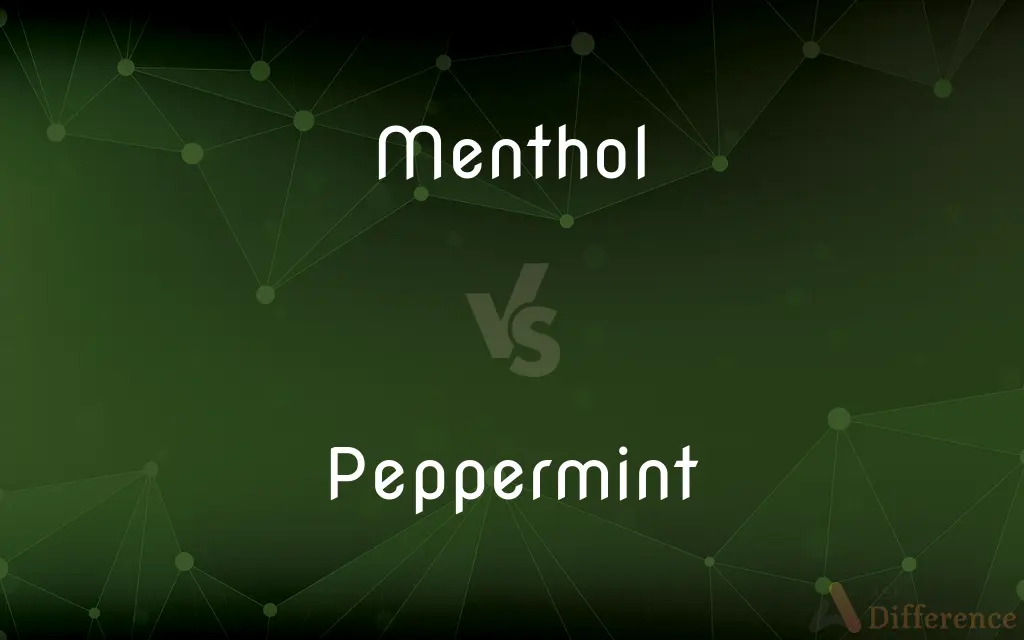Menthol vs. Peppermint — What's the Difference?
By Maham Liaqat & Urooj Arif — Updated on February 26, 2024
Menthol is a compound providing a cooling sensation, found in various plants including peppermint. Peppermint is a plant species known for its high menthol content and distinct flavor.

Difference Between Menthol and Peppermint
Table of Contents
ADVERTISEMENT
Key Differences
Menthol is an organic compound responsible for the cooling sensation in products like toothpaste and medicinal ointments. It is extracted from peppermint and other mint plants, highlighting its role as a key flavoring and soothing agent. Peppermint, a specific mint species, is valued not only for its menthol content but also for its unique, refreshing flavor that distinguishes it from other mint varieties. This makes peppermint a popular choice for culinary, therapeutic, and personal care products.
The extraction of menthol from peppermint underscores the plant's significance in producing menthol-based products. While menthol can be synthesized in a lab, natural extraction from peppermint ensures a high-quality, organically sourced ingredient. This process links the two closely, with peppermint serving as a primary natural source for menthol.
Menthol is utilized for its cooling and analgesic properties, offering relief in topical pain relievers and cold remedies. Peppermint, however, extends beyond its menthol content, used whole or as an extract in foods, teas, and aromatherapy, benefiting digestion and relaxation.
The production of menthol, especially its synthetic version, meets the demand in industries where natural extraction might not suffice. The cultivation of peppermint is driven by the demand for menthol, among other uses. This cultivation reflects the agricultural value of peppermint, which goes beyond extracting menthol to include its leaves and essential oil for diverse applications.
Comparison Chart
Definition
An organic compound with cooling properties.
A plant species known for its high menthol content.
ADVERTISEMENT
Source
Extracted from mint plants, including peppermint.
Grows naturally, cultivated for its leaves and oil.
Primary Use
Cooling sensation, analgesic in products.
Culinary, therapeutic, and personal care products.
Extraction/Production
Can be naturally extracted or synthetically produced.
Cultivated for natural extraction of menthol and oil.
Applications
Topical ointments, toothpaste, confectionery.
Teas, culinary dishes, aromatherapy, medicinal uses.
Compare with Definitions
Menthol
Synthetically produced for various uses.
Synthetic menthol is added to toothpaste for its cooling effect.
Peppermint
Ingredient in culinary recipes.
Fresh peppermint enhances the taste of both sweet and savory dishes.
Menthol
Key ingredient in many medicinal products.
The cough drops contain menthol to soothe the throat.
Peppermint
Cultivated for its essential oil.
The farm grows peppermint primarily for its high-quality essential oil.
Menthol
Found in personal care products.
The lotion contains menthol for a cooling sensation on the skin.
Peppermint
A hybrid herb of the mint family (Mentha × piperita), formed by crossing watermint and spearmint, which has a high menthol content and a sharp flavor and is used in cooking, especially in herb teas and in confections.
Menthol
Used in culinary arts for flavoring.
Menthol is sometimes used to add a refreshing note to desserts.
Peppermint
A volatile oil (oil of peppermint) distilled from the fresh herb; also, a well-known essence or spirit (essence of peppermint) obtained from it.
Menthol
A cooling compound found in mint plants.
Menthol in the cream provides immediate relief to sore muscles.
Peppermint
A mint species with a high menthol content.
Peppermint leaves add a refreshing flavor to the tea.
Menthol
Menthol is an organic compound made synthetically or obtained from the oils of corn mint, peppermint, or other mints. It is a waxy, crystalline substance, clear or white in color, which is solid at room temperature and melts slightly above.
Peppermint
Offers health benefits in herbal medicine.
Peppermint tea is consumed for its digestive and relaxing properties.
Menthol
A fragrant white crystalline organic compound, C10H20O, obtained from peppermint oil or synthesized. It is used in perfumes, in cigarettes, as a mild topical anesthetic, and as a mint flavoring.
Peppermint
Used in therapeutic practices.
Peppermint oil is diffused for its soothing aroma and digestive benefits.
Menthol
A lotion containing menthol which gives it a mint flavoring
Peppermint
Peppermint (Mentha × piperita, also known as Mentha balsamea Wild) is a hybrid mint, a cross between watermint and spearmint. Indigenous to Europe and the Middle East, the plant is now widely spread and cultivated in many regions of the world.
Peppermint
(countable) A confection containing extract of peppermint.
Peppermint
A candy flavored with peppermint oil
Common Curiosities
Can menthol be synthetically produced?
Yes, menthol can be synthesized in laboratories to meet demand in various industries.
Can menthol be found in plants other than peppermint?
Yes, menthol is present in various mint plants but is most abundant in peppermint.
How does peppermint differ from other mint varieties?
Peppermint is distinct for its high menthol content and a unique, refreshing flavor that sets it apart from other mint species.
Is peppermint oil the same as menthol?
No, peppermint oil contains menthol among other compounds; menthol is just one component of peppermint oil.
Why is menthol added to toothpaste and mouthwash?
Menthol is added for its cooling sensation and to help freshen breath.
Are there any side effects to using menthol or peppermint?
In some individuals, excessive use can cause irritation or allergic reactions; moderation is advised.
What makes peppermint popular in aromatherapy?
Its refreshing scent and potential health benefits, such as promoting relaxation and easing digestive issues.
What is menthol primarily used for?
Menthol is used for its cooling and soothing effects in medicinal, personal care, and culinary products.
What are the health benefits of peppermint?
Peppermint offers digestive aid, relief from headaches, and can improve energy levels and relaxation.
Can peppermint be used in cooking?
Yes, peppermint is used in both sweet and savory dishes for its refreshing flavor.
How is menthol extracted from peppermint?
Menthol is extracted through distillation processes that separate it from peppermint oil.
Is there a difference in the quality of natural vs. synthetic menthol?
Some argue natural menthol offers a superior sensory experience, though synthetic menthol provides consistency in products.
How can peppermint be incorporated into a daily diet?
Peppermint can be added to teas, salads, desserts, and beverages for flavor and potential health benefits.
Why do sports creams often contain menthol?
Menthol is used in sports creams for its cooling effect and ability to relieve minor muscle and joint pain.
Can peppermint and menthol be used together in products?
Yes, they are often used together, with peppermint providing flavor and menthol offering cooling properties.
Share Your Discovery

Previous Comparison
Mochaccino vs. Mocha
Next Comparison
Valour vs. ValorAuthor Spotlight
Written by
Maham LiaqatCo-written by
Urooj ArifUrooj is a skilled content writer at Ask Difference, known for her exceptional ability to simplify complex topics into engaging and informative content. With a passion for research and a flair for clear, concise writing, she consistently delivers articles that resonate with our diverse audience.















































